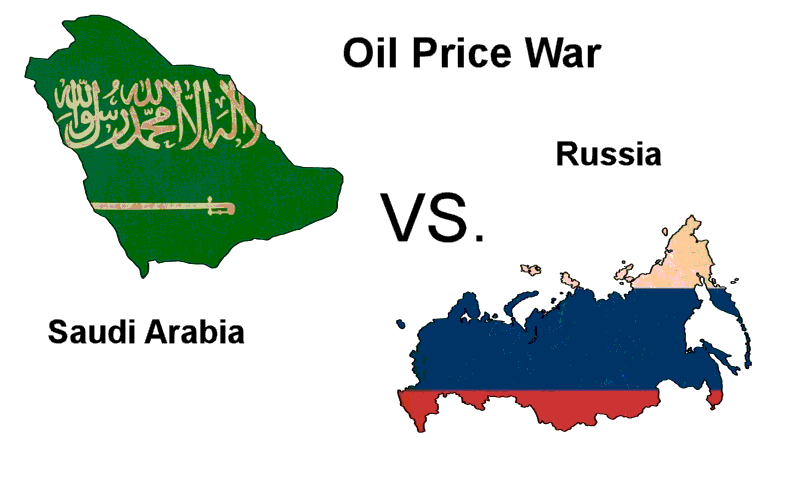
Saudi Arabia and Russia must have known an oil price crash would result when they broke up their three-year-long bromance designed to push up oil prices. Two weeks after the break-up and nearly 4 million bpd of total promised additional oil supply to the market next month, and Riyadh and Moscow are now counting the cost and trying to adjust government spending. The friends-turned-foes expect sharp drops in oil revenues in the near term, not only because Brent Crude is barely managing to cling to the $30 mark these days, but also because the coronavirus pandemic is leading to huge demand destruction.
Saudi Arabia announced this week that it is reducing government expenditures by US$13.2 billion (50 billion Saudi riyals), or nearly 5 percent of its budget spending for 2020 after the government approved “a partial reduction in some items with the least social and economic impact.”
These measures were approved “in light of the noticeable development in the public finance management, and the existence of the appropriate flexibility to take measures in the face of emergency shocks with a high level of efficiency,” says Saudi Minister of Finance and Acting Minister of Economy and Planning, Mohammad Al-Jadaan, the official Saudi Press Agency reported.
The Kingdom “has taken measures to reduce the impact of low prices of oil, and additional measures will be taken to deal with the expected drop in prices,” Saudi Arabia says, nothing that additional expenditures could be re-evaluated and potentially cut.
Even before the collapse of the OPEC+ talks, Saudi Arabia’s finance ministry had asked government agencies to propose a 20-30 percent cut in their budgets due to the oil price slide, Reuters reported last week, citing four sources with knowledge of the plans.
It looks like Saudi Arabia bets on tapping cash from its sovereign wealth fund to patch up government finances with oil prices three times lower than their break-even oil price.
According to Fitch Ratings, Saudi Arabia needs oil prices at $91 a barrel in 2020 to balance its budget, all else being equal.
“For countries in the Gulf Cooperation Council (GCC), we estimate that a change of USD $10 in the price per barrel of oil tends to affect government revenues by 2%-4% of GDP,” Fitch said last week. The rating agency’s statement came a day after oil prices crashed by 25 percent as Saudi Arabia – a GCC member, OPEC’s top producer, and the world’s top oil exporter – vowed to significantly boost supply and slashed the price for its oil in a dramatic shift in its oil price-fixing policies of the past three years.
The Kingdom is signaling that it can adapt to today’s lower oil prices, but analysts are not buying this claim.
At $30 a Brent barrel, the Saudi wealth fund will deplete fast and reduced government spending will stall projects, and the already suffering private non-oil sector will suffer further. That’s the near-term damage.
The longer-term damage is the lack of funds for the ambitious Vision 2030 plan of Saudi Crown Prince Mohammad bin Salman, which was already going downhill even before the oil price collapse as the promised multi-billion foreign investment and Saudi investment in “diversifying away from oil” weren’t exactly flowing to the Kingdom.
“I think we are beginning to see that the vision 2030 is not going well,” Jean-François Seznec, Non-Resident Senior Fellow at Atlantic Council, said on an Atlantic Council press call last week.
There is a growing amount of tension among the population, even among the crown prince’s main supporters, Seznec said.
“But he needs to make a big impact. Now, his big impact is to force the Russians to give up and agree to the cuts, and if at the same time it destroys the U.S. shale industry so much the better,” Seznec noted.
The Russians are also bracing for an oil price war, promising up to a 500,000 bpd production increase and assuring the market they have enough resources to cover budget shortfalls at $25-30 oil for six to ten years.
The coronavirus pandemic and the lower economic activity, coupled with oil prices half the level before Russia and Saudi Arabia broke up the OPEC+ pact, will weigh on Russia’s revenues and budget, too.
Russia’s revenues from oil and gas will be US$39.5 billion (3 trillion rubles) lower than planned, Russian Finance Minister Anton Siluanov said this week, adding that Moscow now expects a budget deficit.
Analysts argue that Russia is in a better fiscal, financial, and political leadership position than Saudi Arabia to win the oil price war.
Yet, there will undoubtedly be economic pain for both sides in this war, which is already claiming the first collateral victims—U.S. shale, Canada’s oil industry, and the UK’s offshore oil and gas sector.
It’s now a game between Saudi Arabia and Russia of who will blink first, and in this game, the Saudis seem to have overestimated their fiscal buffers and underestimated the coronavirus-hit enormous demand destruction.
By Tsvetana Paraskova
This article originally appeared on Oilprice.com and has been reprinted by permission.
You might also like:
- Oil Is Now More Volatile Than Bitcoin
- Did the Oil Crash Wreck the Stock Market?
- Inflation-Adjusted Gasoline Prices
- Inflation-Adjusted Crude Oil Prices Chart
- Inflation-Adjusted Crude Oil Table
